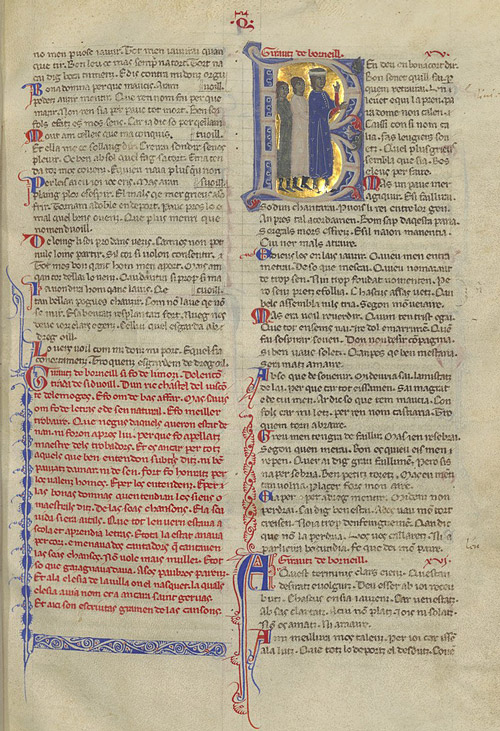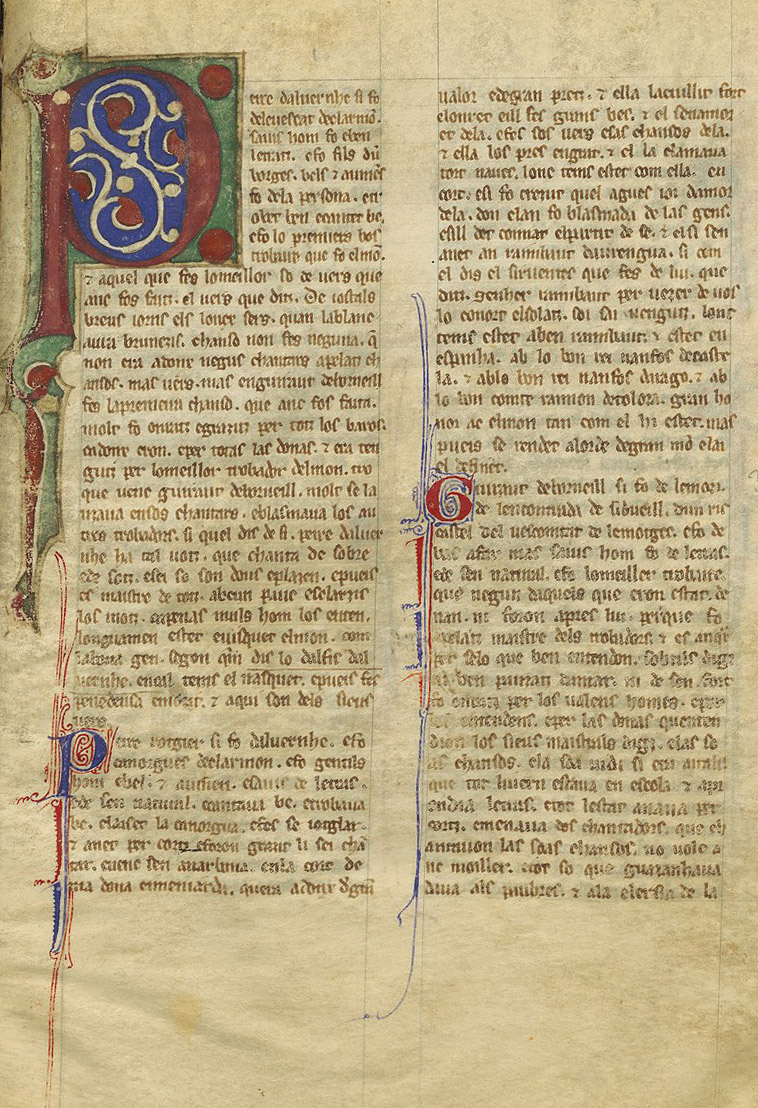
Vidas and razos
Vidas and razos
Vidas and razos 1 are short prose texts that originally served as an introduction to and commentary on the troubadour poems in some cançoners. Vidas give the troubadour’s biography, while razos explain the context of a specific piece. Some 225 of these have survived (Poe 1984: 15, see A few numbers) and most are anonymous, although it is thought that a fair number of them were written by the only two known authors of vidas and razos: Uc de Saint Circ (1175–1237) and Miquel de la Tor (fl. 1260–1340?). In the oldest manuscripts, their function was introductory and they were placed before the corpus of a troubadour or the piece to which they referred, but over time these two genres acquired their own significance as short narratives or stories. Thus in some 14th-century manuscripts, we find them copied as a body of text separate from the poems. And then later authors included them in collections of short narrative, like Masuccio Salernitano’s Novellino, or as elements in more complex narrative constructions, such as Giovanni Bocaccio’s Decameron.

Recent scholarship has highlighted the introductory and pedagogic role of vidas and razos with respect to the troubadours and their work; furthermore, attention has also been drawn to their importance as historical sources on the troubadours —although the information that they provide needs to be approached with caution—, as a way of getting closer to a reading of the poetry through the eyes of medieval readers, and also simply for the charm of the anecdotes we find in them.
Vidas or razos? What’s the difference?
It is not always possible to distinguish clearly between what is a vida and what is a razo because they both have several characteristics in common. Both make use of biographical information, inspired by historical events, but also —sometimes fundamentally— by information that can be deduced from the poems, often taken literally and then creatively embellished by the author of the vida or razo. In fact, some experts in this area have classified half a dozen texts as vidas-razos on the grounds that they cannot be assigned to only one of the two categories. Despite their similarities, however, vidas tend to be shorter (from the 27 words in Bertran d’Alamanon’s vida to the 200 in Guillem de Cabestany’s) and, in narrative terms, simpler than razos. They are also more formulaic: they give the troubadour's name, his birthplace, a characteristic of his work or personality as a troubadour, and the place of his death, along with possible extra material. In contrast, razos are longer and more complex, include quotations from the piece to which they refer, and combine biographical and interpretative elements, which in some cases form a kind of independent tale (Burgwinkle 1999: 251).
In light of these characteristics, scholars initially concluded that vidas predated razos. Nevertheless, more detailed analyses have indicated that the opposite is true: the data that appear in the razos refer to events no later than 1219, while some vidas feature information from after that time. In addition, the first term documented in the manuscripts was razo; the term vida appears much later, in the rubrics of 14th-century songbooks. Even so we do not find a completely systematic classification in the manuscripts; instead, for example, some texts which are in structural terms vidas can be called razos. This suggests that the defining boundary between these two genres is a modern perception not shared by the compilers and the medieval readership (Poe 1995: 194–96).
The origins
Vidas and razos probably existed in oral form before they were collected in songbooks and became a regular element in the copying of troubadour poetry. Before a piece was performed, it is possible that the jongleur or troubadour presented an introduction to explain who the author was or the circumstances that led to the composition. The authors of the first vidas and razos copied into manuscripts could have recorded these oral presentations, and drawn on other documentary or literary sources, or their own creativity. There was also the precedent of biographies and scholarly commentaries, such as the accessus ad auctores (‘introductions to recommended authors’; Meneghetti 1984) and hagiographies, which could have inspired the creators of some vidas and razos. From these possible precedents or models, there is a two-step change: first from a tradition designed for the spoken word, that is later adapted to written transmission; and the second involves the material being made available to an audience socially, culturally or linguistically different to the original one, who needed additional information about the contemporary context and the courtly setting in which the songs were originally performed (Di Girolamo 1989: 263).
Why?
This is perhaps the most difficult question to answer. We know that the mixture of historical fact, literary fact, and imagination that is their hallmark (and which nowadays would make us take exception to a biography or a piece of literary criticism), was common practice in the Middle Ages: the dividing line between these sources of information was much more porous then, and the aim of the author was not to provide verifiable data that would stand up to scrutiny.2 So what was the purpose of the vidas and razos? The first was principally didactic: to provide the audience with the necessary tools to understand a piece or a work.3 However, analysis of the internal structure of the cançoners in which they feature, in particular the oldest exemplars where the vida or razo directly precedes the troubadour’s work, in some cases alongside a miniature, suggests other interesting possibilities. Vidas and razos bring the life of the troubadour and his work together to create a particular image that responds to the audience's interpretative needs and also to the ideological model of the troubadour movement adapted by the compilers. In a poetic tradition where the image of the author is of particular importance, as indicated by way the poems in cançoners are classified by poet, both vidas and razos as well as the accompanying miniatures reinforce this image and give each troubadour distinctive traits.4 At the same time, this image of the author also integrates the corpus of his poetic work within the tradition, all the while creating a cohesive, global view of the troubadour tradition. All this allowed the compilers to present it as an ideological system centred around training, themes, and patronage, thereby creating a kind of literary historiography based on an identity formed around a “cultural practice” rather than a geographical area, ethnic questions, or linguistic uses (Burgwinkle 1999: 249–50).
M. Victoria Rodríguez Winiarski (2017)





Reference list
- Meneghetti, Maria Luisa (1984), Il Pubblico dei Trovatori: ricezione e riuso dei testi lirici cortesi fino al XIV secolo, Modena: Mucchi.
- Meneghetti, Maria Luisa (2003), «La tradizione della lírica provenzale europea», Intorno al testo.Tipologie del corredo esegetico e soluzioni editoriali (Urbino, 1-3 ottobre 2001), Roma: Salerno, 77-99.
- Poe, Elizabeth W. (1984), From Poetry to Prose in Old Provençal, Birminghan (Alabama): Summa.
- Poe, Elizabeth W. (1995), «The vidas and razos», A Handbook of the Troubadours, Berkeley - Los Angeles: University of California Press, 185-197.
- Burgwinkle, William (1999), «The chansonniers as books», The Troubadours, an Introduction, Cambridge: Cambridge UP, 246-262.
- Di Girolamo, Costanzo (1994), Els trobadors, València: Alfons el Magnànim [tr. de I trovatori (1989), Bollati Boringhieri].
